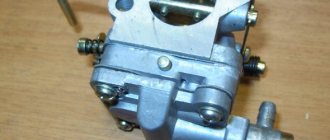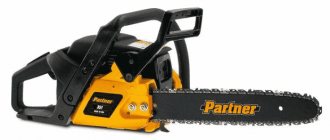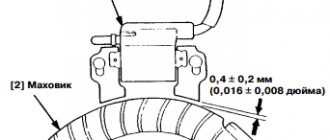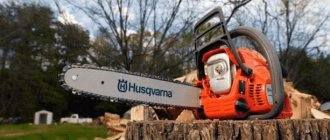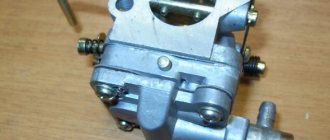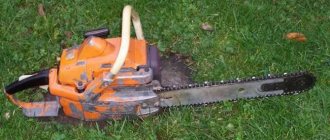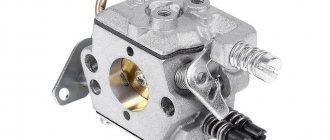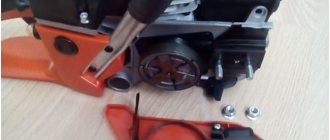We try to repair the chainsaw starter with our own hands
A chainsaw is an indispensable tool not only for summer residents, but also when carrying out construction work. If you need to stock up on firewood for the winter, then going into the forest without a chainsaw makes no sense at all. If the tool is used correctly, it can last a long time, but in any case, sooner or later various types of malfunctions will occur. One of these malfunctions is a breakdown of the starter, which makes it difficult to start the engine. In this situation, it is advisable to repair the chainsaw starter yourself. We will find out how to do this in the material.
Chain brake
A problem with the chain brake may occur due to lubricant or sawdust getting into the system. Here you need to clean all the elements from debris. In addition, the tape may become unusable and then it needs to be replaced.
It happens that some parts of the saw become unusable more often than others, so they will have to be repaired more than once. Most often this is a tire, drive sprocket, chain, anti-vibration parts. To quickly repair and assemble the device, you should always have spare parts on hand.
Durable, time-tested and tested under extreme working conditions, the Champion 142 chainsaw will become a reliable assistant in the household. Using this tool, you can prepare firewood for the fireplace and stove for the winter, and clean the garden and surrounding area in the spring. According to reviews from Champion 142 owners, many of them use a chainsaw when building a house, barn or bathhouse.
The Champion 142 model meets all modern safety requirements, has a long overhaul period and is suitable for use in most climate zones.
- Powerful, unpretentious engine.
- Chrome plated cylinder.
- Effective anti-vibration system.
- "Easy start" function.
- Mechanical inertial brake for instant chain stopping.
- Automatic lubrication system for gearbox and cutting surfaces.
The design and principle of operation of a chainsaw starter
All types of chainsaws, both Chinese and European, are equipped with starters of identical design and operating principle. The universal design of starters allows these devices to be used both on branded chainsaws and on semi-official tools supplied from the Middle Kingdom. It is only important to note that domestically produced instruments have some distinctive features.
A starter for a chainsaw is a simple mechanism consisting of:
The operating principle of such a device is also quite simple. When the handle, which is connected by a cable to the drum of the ratcheting mechanism, is pulled, it moves. When moving, the drum engages with the splines of another drum, which is located on the shaft. Thus, the crankshaft of the saw moves manually, which makes several revolutions. As soon as the handle returns to its original position, assisted by the return spring, the spline connection is lost, causing the shaft to stop. With each movement of the crankshaft, the amount of fuel-air mixture in the cylinder increases, which ultimately contributes to its ignition.
The greater the power of the tool, the more jerks the starter must make to start the engine. The return spring, which is manufactured using steel with a high degree of elasticity, is responsible for accelerating the return of the drum to its original position.
Over time, with constant use of the tool, problems are observed with starting the engine, or more precisely, with the functioning of the starter. If such problems arise, the starter can always be repaired. If you know the principle and design of the starter, then repairing it yourself will not be difficult at all.
Typical breakdowns and repairs of a chainsaw starter
Before carrying out repairs, it is necessary to find out the causes of the breakdown. Since the product is constantly exposed to dynamic and other types of loads, its failure cannot be ruled out. Frequent causes of starter breakdowns are: cable rupture, abrasion or chipping of several splines of the ratchet drum, spring damage, pulley crack, and others. To determine why the saw does not start, you will need to carry out an appropriate inspection of the starter mechanism. Let's look at the main types of faults, and also find out how to properly repair the product.
Replacing the cord
The starter cord is a strong rope that is quite resistant to wear, but even its technical properties do not save it from damage. Each time the tool is started, the rope rubs against the body of the starter cover, which leads to its gradual chafing and wear.
If the cord is frayed, then to replace it you will need to disassemble the housing of this unit. After removing the cover, it is necessary to lift the drum, but only in such a way that it does not jump out of its seats. It is recommended to carry out this work together with a partner who will fix the spring, and you will replace the cable. The remains of the old cable should be removed, and then the new product should be secured in the handle and in the groove of the drum. After this, the cable should be wound onto the roller, and finally assemble the housing.
It is important to know! Before fixing the cable in the handle, you should pass it through the corresponding hole in the starter cover.
How to replace a chainsaw starter spring
If the spring is damaged, which often happens on Chinese instruments, then the mechanism can only be repaired by replacing it. But if its damage occurred at the point of attachment, that is, the ear burst, then it can be repaired.
Repairing a spring involves heating the fracture site to 600 degrees, then slowly cooling it to 100 degrees, at which point the end is folded into the shape of the fragment. Thus, it will be possible to avoid loss of elasticity of the product, which will extend its service life. Although most specialists simply replace the product with a new one.
The spring replacement process is carried out in the following sequence:
The detailed process of replacing the spring is discussed in the video:
Replacing flywheel pawls
If it is necessary to replace the pawls or flywheel links, then this is also not difficult to do. To do this, you will need to dismantle the flywheel and then remove the pawls. New pawls should only be installed as they were originally (plastic or metal). This is very important, since replacing plastic pawls with metal ones will lead to accelerated wear of the flywheel. Details of replacing the chainsaw starter dogs are discussed in the video below.
In conclusion, it is important to note that you do not need to have any special skills or experience to repair a chainsaw starter. All work can be done independently if you treat the repair process with full responsibility. Timely maintenance of the chainsaw will allow you to avoid breakdowns when performing work in the field.
Source
Related Posts
Repairing a chainsaw yourself
Our client is left with chainsaw malfunctions divided into two main groups: engine malfunctions with its complete components and systems (ignition, fuel supply system, cylinder-piston group, exhaust system) and malfunctions of other components (chain brake, lubrication system, clutch, tire etc.).
Engine malfunctions
- The engine will not start;
- starts, but stalls;
- works unsteadily;
- does not develop power, i.e. It runs fine at idle, but stalls under load.
Repairing a chainsaw yourself
, you need to act by elimination. Our client is left to check one by one the possible causes of the malfunction, starting with the development of those, the verification and elimination of which takes less time (see here about the device and operation of a two-stroke engine).
Ignition system
. Almost all types of engine problems listed above can be caused by ignition system failures. Therefore, when they occur, it makes sense to start troubleshooting with a spark plug. This is all the more justified since the state of the latter can provide useful information about the operation of the fuel system. So, if a problem occurs, you need to unscrew the spark plug and inspect it.
The wire is disconnected and the spark plug is unscrewed with a special wrench.
If the spark plug is dry, this means that the problem is most likely not in the ignition system, but in the fuel mixture
. You can wrap the spark plug back and get to work on the fuel system. If the spark plug is heavily splashed with fuel mixture, it means there is an excess of it. This may occur due to carburetor misadjustment or violation of starting rules. The spark plug is wiped and dried, the cylinder is dried by turning off the fuel supply and operating the starter. to ventilate the combustion chamber and remove excess fuel. Then install the spark plug in place and repeat the start.
The presence of a large amount of black carbon also indicates a malfunction in the fuel system.
The ratio between oil and gasoline in the mixture may be incorrect, the carburetor may not be adjusted, or low-quality oil may be used. The spark plug is washed in gasoline, cleaned of carbon deposits with a needle or awl, the electrodes are cleaned with fine sandpaper and replaced.
In all these cases, it would be a good idea to check the gap between the spark plug electrodes. Depending on its brand, it should be in the range of 0.5-0.65 mm. You also need to check the spark plug seal. If it is worn out or damaged, the tightness of the combustion chamber may not be ensured, which leads to a decrease in compression in the cylinder and problems in engine operation.
Even if, when checking the spark plug, there is good reason to believe that the fault is in the fuel system, you need to check the spark plug for the presence of a spark. At least to be sure that everything is in order. For this:
- put the ignition cable on the spark plug;
- using pliers with insulated handles, apply the thread or nut of the spark plug to the cylinder;
- pull the starter handle and watch. whether there is a spark
or not.
How to repair a chainsaw starter
Today we’ll look at problems with chainsaw starter malfunctions and we’ll fix them. This type of breakdown is not uncommon during intensive use of a gas-powered saw. And in our case, at logging sites, this happens systematically. How to repair a chainsaw starter.
So, the chainsaw starter is designed to start the tool. On gearless saws it is located in the side cover on the flywheel side (left side of the tool). This is a purely mechanical principle of operation. But in order to repair the starter competently and efficiently, it is necessary to understand the principle of its functionality (work). I propose to consider this issue carefully.
On top of the starter cover (housing) there is a handle in a special seat in the cover. The handle is connected to a cord, which in turn is wound on a pulley and the end of the cord is secured to the pulley. When the operator (chainsaw user) jerks the handle up, the cord unwinds along the pulley (reel), bringing it into a “centrifugal” state. The pulley has in its design (on the back side) a ratchet - this is a gear with teeth rounded in one direction. The teeth of the gear (ratchet) engage with “pawls”, which are located on the drum (flywheel) of the crankshaft. The crankshaft rotates, the fuel is compressed under the pressure of the piston and the head of the “engine”. Meanwhile, the operator lowers the handle, the return spring, which is attached to the reel (pulley), winds the cord to its original state (on the reel). Meanwhile, the teeth of the ratchet slide along the “pawls” of the flywheel, eliminating contact with them, since they rotate in the opposite direction. Let me remind you that the teeth of the ratchet are rounded in one direction - it is this principle that allows engagement with the “pawl” splines of the crankshaft. By rotating in the opposite direction, engagement with the pawls is eliminated.
Purpose of Champion 137
The chainsaw is intended for household use only. It can be used in the country house, used for trimming branches or preparing firewood for the barbecue. The Champion 137 is suitable for outdoor enthusiasts as it is the lightest saw in the Champion line of household chainsaws.
The manufacturer's recommendations for the use of this chainsaw are rarely followed in our country, and therefore the Champion 137 can be found at sawmills where it is used to cut slabs. Private offices that collect and sell firewood to the public also often use this chainsaw.
The 137th model is popular because it has a low cost. Another advantage is the cost of repairs and a large number of spare parts. Specialized stores have a large selection of both original and made-to-measure handicraft spare parts.
User manual
As for the instructions, it is included in the kit, but it is immediately noticeable that this is not an official Champion instruction, but a homemade one made to match it. On the manual pages, although there is a corporate logo, the content clearly reveals a fake.
If you don’t get too picky, the instructions are informative; they contain all the necessary information that will help you prepare the tool for use, diagnose malfunctions, and use the chainsaw correctly. The manual will also help you sharpen the saw chain correctly, as it contains a detailed description of the process.
Design Features
Champion 137 does not have any design features; everything is done as simply and cheaply as possible. The engine is ordinary - two-stroke, diaphragm carburetor, starter without additional springs, but this does not mean that the chainsaw is bad. It’s pleasant to hold in your hands and it starts up no worse than Husqvarna’s household model, for example, the 236th.
There are still minor improvements, such as an additional fuel pump, which is designed to make starting easier after a long period of inactivity, as well as a chain tension regulator mounted on the side cover, which is quite convenient.
In the latest versions of the Champion 137, the manufacturer added a hatch in the top cover, through which you can access the air filter and spark plug without the use of additional tools. Comfortable? Of course it’s convenient, because previously, every time you needed to check the cleanliness of the air filter, you had to unscrew the 4 screws securing the top cover and remove it completely.
The saw controls are made as simple as possible; there are no combination levers or anything else. A separate choke control lever, which is mounted on the body to the right of the rear handle. Reliable and inexpensive push-button ignition switch.
At first glance at the saw, it becomes clear that this is a budget option without any bells and whistles. Below you can watch a video test of the Champion 137 saw.
DIY repair
You can repair the Champion 137 either at a service center or yourself. Typical malfunctions of this model are as follows:
If you have some experience, you can diagnose and fix faults yourself.
If for some reason the chainsaw does not hold or picks up speed at idle, this is the first sign of air leaking into the crankcase or carburetor. It is impossible to operate a saw with such a malfunction, since overheating and jamming of the engine will follow.
How to disassemble champion 137
In order to disassemble Champion 137 yourself you need to know only two basic rules:
The chainsaw parts are removed in the following order;
When assembling, the reverse sequence must be observed.
The Champion 137 chainsaw housing must be installed with red sealant; the sealant cannot be used anywhere else.
If, when disassembling the Champion 137 chainsaw, the carburetor gaskets and spacers were damaged, then they must be replaced during reassembly, otherwise the saw will suck in air and all repairs will be in vain.
In order to check the crankshaft seals for air leaks in the absence of a special tool, you can use the following method.
Remove the flywheel, clutch and carburetor from the chainsaw, then use a syringe to pour kerosene into the engine crankcase (if there is no kerosene, then you can use the fuel mixture), while visually checking the seals for leaks. If there are leaks, then the seals are defective and need to be replaced.
Ignition faults
Most often, we think about repairs after the chainsaw stops starting, or visual signs of serious damage appear.
Signs of ignition malfunction:
- The chainsaw starts, but works unevenly (troits), often sneezes and shoots;
- The power of the chainsaw has noticeably dropped;
- When you sharply press the accelerator trigger, failures in engine operation are observed;
- The chainsaw does not start well when cold, it stalls violently until it warms up;
- Fuel consumption has increased significantly;
If such flaws appear in the operation of your chainsaw, then it’s time to diagnose, adjust, and possibly repair the ignition system.
Fault location determination:
First of all, it is necessary to inspect the spark plug; if a lot of carbon deposits have accumulated on it, then the cause of the malfunction is most likely related to the operation of the carburetor, piston group or fuel quality. If the spark plug visually appears to be in good working order, does not spark and is dry, make sure there is a spark.
- Unscrew the spark plug, put the ignition cable on it;
- Using insulated pliers, press the spark plug threads to the motor housing;
- Pull the starter handle sharply towards you and make sure there is a spark;
If there is no spark, replace the spark plug with a new one and test again. After making sure there is a spark, start the engine. But what to do if there is no spark even on a working spark plug? Let's continue the search:
- We test the electrical cable for breaks and insufficient contact with the spark plug. We check the serviceability of the spring in the cap of the candle holder and the presence of contact with the armored cable;
To check the serviceability of electrical wiring, it is best to use a tester.
- We check the gap between the ignition module and the flywheel magnetic circuit. It should be no more than 0.3 - 0.4 mm.
You can set the correct gap using a feeler gauge; they are not in short supply and are available for a small fee.
Diagnosing a fault with a multimeter
The malfunction of the ignition coil can also be determined using the so-called hardware method. However, for this you must have a multimeter with which diagnostics are carried out.
Step-by-step ignition diagnostics with a multimeter:
- We set the multimeter to a position where the arrow is at the 200 ohm mark.
- We study the instructions for the chainsaw. We find out the optimal resistance for the winding of the coil installed on our model (in most modern chainsaws this indicator ranges from 3-5 Ohms);
- We connect a multimeter to the primary winding of the coil and measure the resistance, if it is normal, we continue testing;
- We connect the multimeter to the secondary winding of the coil, compare the readings obtained with those indicated in the instruction manual;
- We connect the multimeter to the hole in the coil into which the wires are inserted. If the device produces normal readings, we come to the conclusion that the coil is working properly. If the measurement results are far from optimal, you will have to replace the assembly (coil) with a new one;
Video review of fault determination using a multimeter
Ignition adjustment
As we have already noted, you can adjust the ignition system both in the workshop and at home. To do this, you will need ordinary wrenches, a screwdriver and a 0.4 mm feeler gauge (you can make a feeler gauge yourself from scrap materials - regular copier paper, a plastic bottle, etc.).
Step-by-step adjustment of the chainsaw ignition:
- We diagnose the malfunction;
- Remove the protective cover;
- We remove the module with a candle holder and an electrical cable. We carry out a visual inspection of them and, if necessary, replace them with a new one;
- We install the ignition module, but do not tighten the fastening screws all the way;
We determine the area with the magnet on the flywheel;
- We set the gap properly, in accordance with the parameters specified in the instruction manual;
- We tighten the module fastening screws until they stop, check the settings with a feeler gauge, and, if necessary, re-adjust;
- We install the protective cover and check for the presence of a spark on the spark plug;
- We screw in the spark plug and start the chainsaw;
Important: when repairing the ignition of a chainsaw, special attention should be paid to setting the correct gap between the module and the flywheel.
You should also check whether the counterweight flywheel is catching on the module. If this happens, you may have a failed bearing or play in the shaft.
Adjusting the carburetor of the Champion 137 chainsaw
Adjustment can correct the situation only when there is no air leak in the saw and the fuel system is clogged, and the chainsaw continues to gain speed at idle or does not develop speed and full power.
The Champion 137 carburetor is a diaphragm carburetor and has three standard adjustment screws (H), (T) and (L). Correct setup is carried out according to the following algorithm:
A properly adjusted carburetor ensures stable engine idling and makes it responsive.
Owner reviews
Alexander. 45 years. Beloyarsk.
For more than a year and a half I have been the owner of a Champion 137. I really like the saw, although I rarely use it, only when I need to prepare firewood for the barbecue and bathhouse. In all the time that I have owned this saw, it has failed only once. As it turned out later, I myself violated the launch algorithm and filled the candle. After reading the instructions, I found out how to ventilate the engine after an unsuccessful start-up attempt and started the saw myself, although it smoked heavily for some time, but then the exhaust returned to normal. I'm happy with the saw and recommend it.
I bought a Champion 137 after my Shtil 180 broke down, and the cost of repairs turned out to be equivalent to buying a Champion 137. Now I regret it a little. As soon as you take the Champion in your hands, you immediately feel the difference with the Calm. The saw starts worse when hot and cuts worse, but I reassure myself that I paid for it almost half as much as the new Shtil 180 costs. Most likely, this saw will suit those who have not previously dealt with chainsaws.
